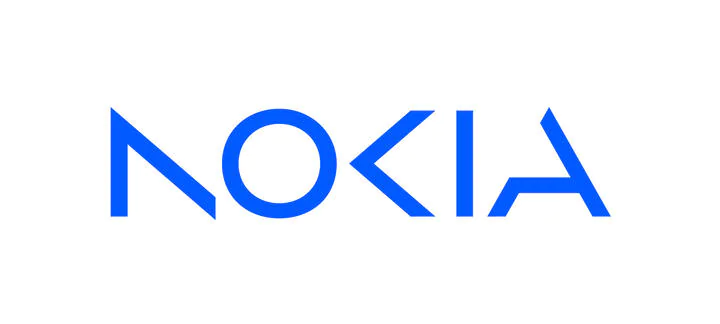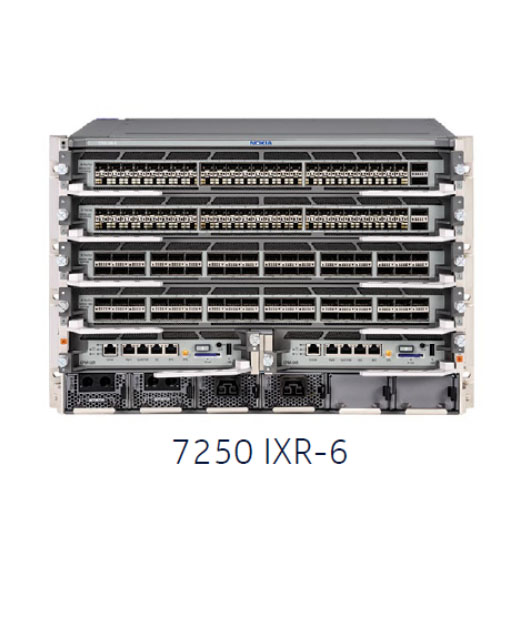Nokia 7250 IXR 6
Interconnect Routers
Nokia IXR-6 routers enable high-scale interconnectivity in data centers and across WANs and aggregation networks in service provider, enterprise and webscale environments.
The IXR-6 interconnect router complements IP edge and core router platforms to deliver enhanced, cost-effective IP network architectures. The 7250 IXR delivers a comprehensive set of IP/MPLS, synchronization and quality of service (QoS) capabilities. Flexible traffic management includes big buffering, per-port queuing, shaping and policing.
Nokia 7250 IXR Product Family
The Nokia 7250 Interconnect Router (IXR) family addresses evolving demands driven by the cloud, 5G and the Internet of Things. The IXR-10, IXR-6 and IXR-s routers enable high-scale interconnectivity in data centers and across WANs and aggregation networks in service provider, enterprise and webscale environments.
The 7250 IXR-6 is optimized for high-density aggregation, and is equipped with high performance 100GE (Gigabit Ethernet), 50GE2, 40GE, 25GE, 10GE and GE interfaces to scale networks to meet evolving traffic demands.
Features & Benefits
- Per-service, hierarchical queuing features support differentiated QoS, which is ideal for any-G aggregation and fixed-mobile network convergence. These features also help industrial enterprises attain IT/OT (informational technology/operational technology) convergence by simultaneously carrying both their business and operational traffic.
- The 7250 IXR sets the benchmark for high availability. The 7250 IXR-10 and IXR-6 systems support a full suite of 1+1 control, 5+1 fabric, and redundant fan and power configurations. In addition to full hardware redundancy, the robust Nokia Service Router Operating System (SR OS) supports numerous features to maximize network stability, ensuring that IP/MPLS protocols and services run without interruption. These features include innovative nonstop routing, nonstop services and stateful failover.
- To simplify and automate network operations, the 7250 IXR enables model-driven network management features through the Nokia SR OS and is managed by the Nokia Network Services Platform (NSP). The Nokia NSP offers a rich set of service management features that automate new service delivery and reduce operating cost. Standards-based software-defined networking (SDN) interfaces enable best-path computation to be offloaded to path computation elements (PCEs) such as the Nokia NSP. The 7250 IXR operates as a path computation client (PCC), collecting and reporting perlink and per-service delay, jitter and loss metrics as well as port utilization levels, for efficient path computation.
Differentiated service support
High availability
Automation
Software Features
- Point-to-point Ethernet pseudowires/virtual leased line (VLL)
- Ethernet Virtual Private Network (EVPN)
- Virtual Private Wire Service (EVPN-VPWS)
- Virtual Private LAN Services (EVPN-VPLS): IPv4 and IPv6 support, including Virtual Router Redundancy Protocol (VRRP)
- Multihoming with single active or active/active mode
Multipoint Ethernet VPN services with VPLS based on Targeted Label Distribution Protocol (T-LDP) and Border Gateway Protocol (BGP)
- Routed VPLS with Internet Enhanced Service (IES) or IP-VPN, IPv4 and IPv6
- Ingress and egress VLAN manipulation for Layer 2 services
- IP VPN Virtual Private Routed Network (VPRN), Inter- Autonomous System (Inter-AS) Option A, B and C
- IPv6 VPN Provider Edge (6VPE)
- Segment routing
- Intermediate System-to-Intermediate System(SR-ISIS) and Open Shortest Path First (SR-OSPF)
- Traffic engineering (SR TE) IPv4, IPv6
- MPLS label edge router (LER) and label switching router (LSR) functions
- Label Distribution Protocol (LDP)
- Resource Reservation Protocol with traffic engineering (RSVP-TE)
- BGP - Labeled Unicast (BGP-LU) (IETF RFC 3107) route tunnels
- IP routing
- Dual-stack Interior Gateway Protocol (IGP)
- Multi-topology, multi-instance Intermediate System to Intermediate System (IS-IS)
- Multi-instance OSPF
- Multiprotocol BGP (MP-BGP)
- BGP-LU support in edge, area border router(ABR) and autonomous system boundary router (ASBR) roles
- Usage-triggered download of BGP label routes to Label - Forwarding Information Base (L-FIB)
- Accumulated IGP (AIGP) metric for BGP
- BGP monitoring protocol (BMP)
- BGP route-reflector for EVPN and IP-VPN with VPNv4 and VPNv6 address families (AFs)
- BGP confederations
- IGP and BGP shortcuts
- Layer 3 Multicast - base routing
- Internet Group Management Protocol (IGMP)
- Protocol Independent Multicast - Sparse Mode (PIM-SM), Source Specific Multicast (SSM)
- Multicast Listener Discovery (MLD)
- Layer 3 Multicast - VPRN (7250-IXR-s)
- Next-generation multicast VPNs (NG-MVPN)
- SSM with multicast LSPv4 (mLDPv4)
- IGMP/MLD
- IGMP/MLD on Routed VPLS Interface
- Layer 2 Multicast
- IGMP/MLD snooping
- SR-TE LSPs, RSVP-TE LSPs
- PCC initialized, PCC controlled
- PCC initialized, PCE computed
- PCC initialized, PCE controlled
- SR-TE LSPs: PCE initialized, PCE controlled (7250 IXR-s)
- Topology discovery: BGP-Link State (BGP LS) IPv4 and IPv6
- Telemetry: streaming interface statistics, service delay and jitter metrics
- Netflow/cflowd
- Nonstop routing (7250 IXR-10 and IXR-6)
- Segment routing topology-independent loop-free alternate (TI-LFA) and remote loop-free alternate (rLFA)
- LDP LFA and rLFA
- IEEE 802.3.ad Link Aggregation Group (LAG) and multi-chassis (MC) LAG
- Pseudowire and LSP redundancy
- IP and MPLS load balancing by equal-cost multipath (ECMP)
- Weighted LAG hash
- VRRP
- Ethernet Ring Protection Switching ITU-T G.8032v2 (7250 IXR-s)
- Configurable polynomial and hash seed shift
- Entropy label (IETF RFC 6790)
- RSVP-TE Fast Reroute (FRR)
- BGP Edge and Core Prefix Independent Convergence (BGP PIC)
- Ethernet IEEE 802.1Q (VLAN) and 802.1ad (QinQ)with 9k jumbo frames
- Detailed forwarded and discarded counters for service access points (SAPs) and network interfaces in addition to port-based statistics: per Virtual Output Queue (VoQ) packet and byte counters (7250 IXR-s)
- VLAN range-based SAPs
- Dynamic Host Configuration Protocol (DHCP)server for IPv4 IES, VPNv4
- DHCP relay, IPv4 and IPv6, IES, IP-VPN, EVPN-VPLS
- Accounting records
- Hierarchical QoS (7250 IXR-s)
- Hierarchical egress schedulers and shapers per forwarding class, SAP, network interface, port or LAG
- Port sub-rate
- Intelligent packet classification, including MAC,
- IPv4, IPv6 match-criteria-based classification
- Granular rate enforcement with up to 32 policers per SAP/VLAN, including broadcast, unicast, multicast and unknown policers
- Hierarchical policing for aggregate rate enforcement
- Strict priority, weighted fair queuing schedulers
- Congestion management via weighted random early discard (WRED)
- Egress marking or re-marking
- Simple Network Management Protocol (SNMP)
- Model-driven (MD) management interfaces
- NETCONF
- MD CLI
- Remote Procedure Call (gRPC)
- Comprehensive management with Nokia NSP
- IEEE 802.1ag, ITU-T Y.1731: Ethernet Connectivity Fault Management for both fault detection and performance monitoring, including delay, jitter and loss tests
- Ethernet bandwidth notification with egress rate adjustment
- IEEE 802.3ah: Ethernet in the First Mile
- Bidirectional Forwarding Detection IPv4 and IPv6
- Micro-BFD - per member link (7250 IXR-s)
- Two-Way Active Measurement Protocol (TWAMP), TWAMP Light
- A full suite of MPLS OAM tools, including LSP and virtual circuit connectivity verification ping
- Service assurance agent
- Mirroring with slicing support:
- Port
- VLAN
- Filter output: Media Access Control (MAC), IPv4/IPv6 filters
- Local/remote
- Port and VLAN loopback with MAC swap
- Configuration rollback
- Zero Touch Provisioning (ZTP) capable Security
- MACsec on all ports (7250 IXR-10 and IXR-6)
- Remote Authentication Dial-In User Service (RADIUS), Terminal Access Controller Access Control System Plus (TACACS+), and comprehensive controlplane protection capabilities
- MAC-, IPv4- and IPv6-based access control lists and criteria-based classifiers
- Secure Shell (SSH)
The 7250 IXR supports, but is not limited to, the following features.
Services
Network protocols
SDN
Load balancing and resiliency
Platform
QoS and traffic management
System management
Operations, administration and maintenance







